A Miniature Fabry–Pérot Fiber Interference Sensor Based on Polyvinyl Chloride Membrane for Acoustic Pressure Sensing in Mid–High-Frequency Band
Abstract
:1. Introduction
2. FPI Pressure Sensor Design and Simulation
2.1. FPI Pressure Sensor Design and Fabrication
2.2. Natural Frequency Analysis of Pressure-Sensitive Membrane
3. Experimental Section
4. Results and Discussion
5. Conclusions
Author Contributions
Funding
Institutional Review Board Statement
Informed Consent Statement
Data Availability Statement
Conflicts of Interest
References
- Ran, Z.; Liu, S.; Liu, Q.; Wang, Y.; Bao, H.; Rao, Y. Novel High-Temperature Fiber-Optic Pressure Sensor Based on Etched PCF F-P Interferometer Micromachined by a 157-Nm Laser. Sens. J. IEEE 2015, 15, 3955–3958. [Google Scholar] [CrossRef]
- Jin, L.; Guan, B.-O.; Wei, H. Sensitivity Characteristics of Fabry-Perot Pressure Sensors Based on Hollow-Core Microstructured Fibers. J. Lightwave Technol. 2013, 31, 2526–2532. [Google Scholar] [CrossRef]
- Xu, J.; Wang, X.; Cooper, K.L.; Wang, A. Miniature All-Silica Fiber Optic Pressure and Acoustic Sensors. Opt. Lett. 2005, 30, 3269. [Google Scholar] [CrossRef]
- Lee, B.H.; Kim, Y.H.; Park, K.S.; Eom, J.B.; Kim, M.J.; Rho, B.S.; Choi, H.Y. Interferometric Fiber Optic Sensors. Sensors 2012, 12, 2467–2486. [Google Scholar] [CrossRef] [PubMed] [Green Version]
- Huang, Y.W.; Tao, J.; Huang, X.G. Research Progress on F-P Interference—Based Fiber-Optic Sensors. Sensors 2016, 16, 1424. [Google Scholar] [CrossRef] [PubMed] [Green Version]
- Wang, N.; Tian, W.; Zhang, H.; Yu, X.; Yin, X.; Du, Y.; Li, D. An Easily Fabricated High Performance Fabry-Perot Optical Fiber Humidity Sensor Filled with Graphene Quantum Dots. Sensors 2021, 21, 803. [Google Scholar] [CrossRef] [PubMed]
- Xia, P.; Tan, Y.; Yang, C.; Zhou, Z.; Yun, K. A Composite Fabry-Perot Interferometric Sensor with the Dual-Cavity Structure for Simultaneous Measurement of High Temperature and Strain. Sensors 2021, 21, 4989. [Google Scholar] [CrossRef]
- Zhang, P.; Wang, Y.; Chen, Y.; Lei, X.; Qi, Y.; Feng, J.; Liu, X. A High-Speed Demodulation Technology of Fiber Optic Extrinsic Fabry-Perot Interferometric Sensor Based on Coarse Spectrum. Sensors 2021, 21, 6609. [Google Scholar] [CrossRef]
- Martin, P. Near-Infrared Diode Laser Spectroscopy in Chemical Process and Environmental Air Monitoring. Chem. Soc. Rev. 2002, 31, 201–210. [Google Scholar] [CrossRef]
- Sigrist, M.W.; Bartlome, R.; Marinov, D.; Rey, J.; Vogler, D.E.; Wachter, H. Trace Gas Monitoring with Infrared Laser-Based Detection Schemes. Appl. Phys. B-Lasers Opt. 2008, 90, 289–300. [Google Scholar] [CrossRef]
- Kapp, J.; Weber, C.; Schmitt, K.; Pernau, H.-F.; Wöllenstein, J. Resonant Photoacoustic Spectroscopy of NO2 with a UV-LED Based Sensor. Sensors 2019, 19, 724. [Google Scholar] [CrossRef] [PubMed] [Green Version]
- Gong, Z.; Chen, K.; Yang, Y.; Zhou, X.; Peng, W.; Yu, Q. High-Sensitivity Fiber-Optic Acoustic Sensor for Photoacoustic Spectroscopy Based Traces Gas Detection. Sens. Actuators B Chem. 2017, 247, 290–295. [Google Scholar] [CrossRef]
- Mitrayana, L.; Maarif, M.; Wasono, M.; Ikhsan, M.; Satriawan, M. Application of the CO2 Laser Photoacoustic Spectroscopy in Detecting Ammonia Gas (NH3) in Liver Disease Patient’s Breath. Key Eng. Mater. 2020, 840, 399–405. [Google Scholar] [CrossRef]
- Ma, J.; Xuan, H.; Ho, H.L.; Jin, W.; Yang, Y.; Fan, S. Fiber-Optic Fabry-Pérot Acoustic Sensor With Multilayer Graphene Diaphragm. IEEE Photonics Technol. Lett. 2013, 25, 932–935. [Google Scholar] [CrossRef]
- Buckel, W. Structure and Properties of Thin Film. In Proceedings of the International Conference Held at Bolton Landing, New York, NY, USA, 9–11 September 1959. [Google Scholar]
- Batzill, M. ChemInform Abstract: The Surface Science of Graphene: Metal Interfaces, CVD Synthesis, Nanoribbons, Chemical Modifications, and Defects. Surf. Sci. Rep. 2012, 67, 83–115. [Google Scholar] [CrossRef]
- Brebu, M.; Vasile, C.; Rovana Antonie, S.; Chiriac, M.; Precup, M.; Yang, J.; Roy, C. Study of the Natural Ageing of PVC Insulation for Electrical Cables. Polym. Degrad. Stab. 2000, 67, 209–221. [Google Scholar] [CrossRef]
- Bucaro, J.A.; Lagakos, N.; Houston, B.H.; Jarzynski, J.; Zalalutdinov, M. Miniature, High Performance, Low-Cost Fiber Optic Microphone. J. Acoust. Soc. Am. 2005, 118, 1406–1413. [Google Scholar] [CrossRef]
- Yu, B.; Kim, D.W.; Deng, J.; Xiao, H.; Wang, A. Fiber Fabry-Perot Sensors for Detection of Partial Discharges in Power Transformers. Appl. Opt. 2003, 42, 3241. [Google Scholar] [CrossRef]
- Ma, J.; Ju, J.; Jin, L.; Jin, W. A Compact Fiber-Tip Micro-Cavity Sensor for High-Pressure Measurement. IEEE Photonics Technol. Lett. 2011, 23, 1561–1563. [Google Scholar] [CrossRef]
- Weiss, K.R. Vibration Problems in Engineering. Nature 1965, 208, 964–965. [Google Scholar] [CrossRef]
- Richards, P. Bolometers for Infrared and Millimeter Waves. J. Appl. Phys. 1994, 76, 1–24. [Google Scholar] [CrossRef] [Green Version]

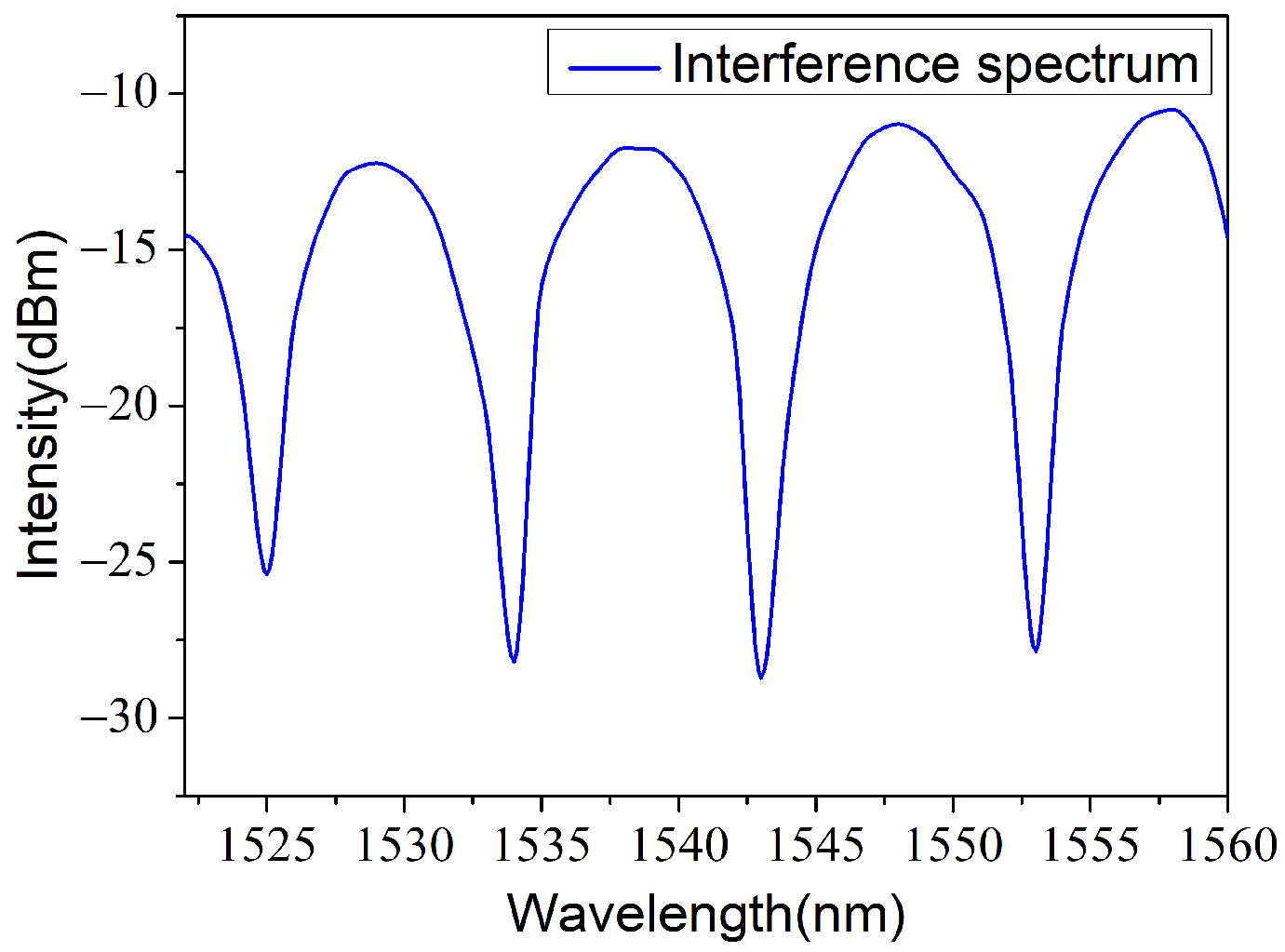
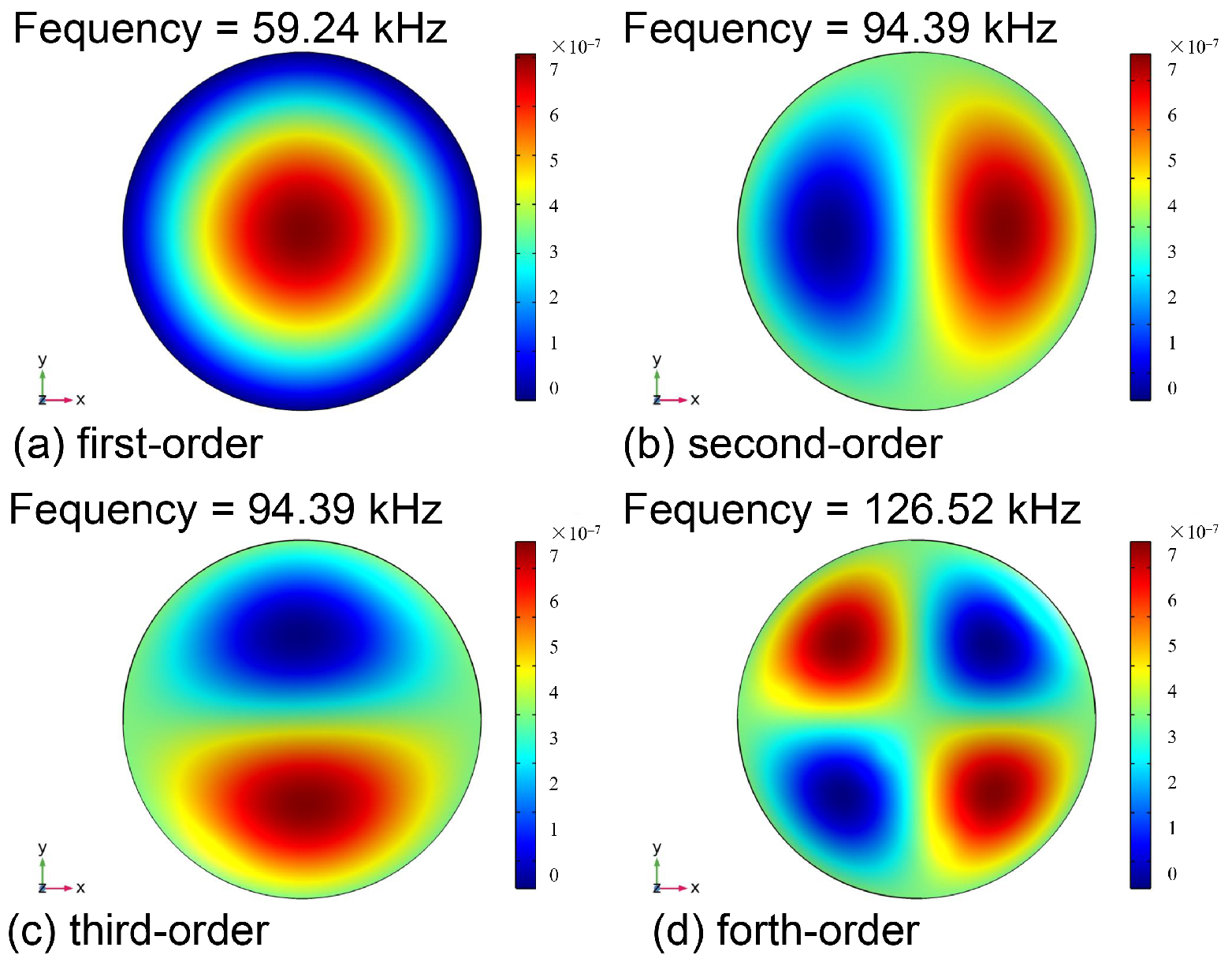

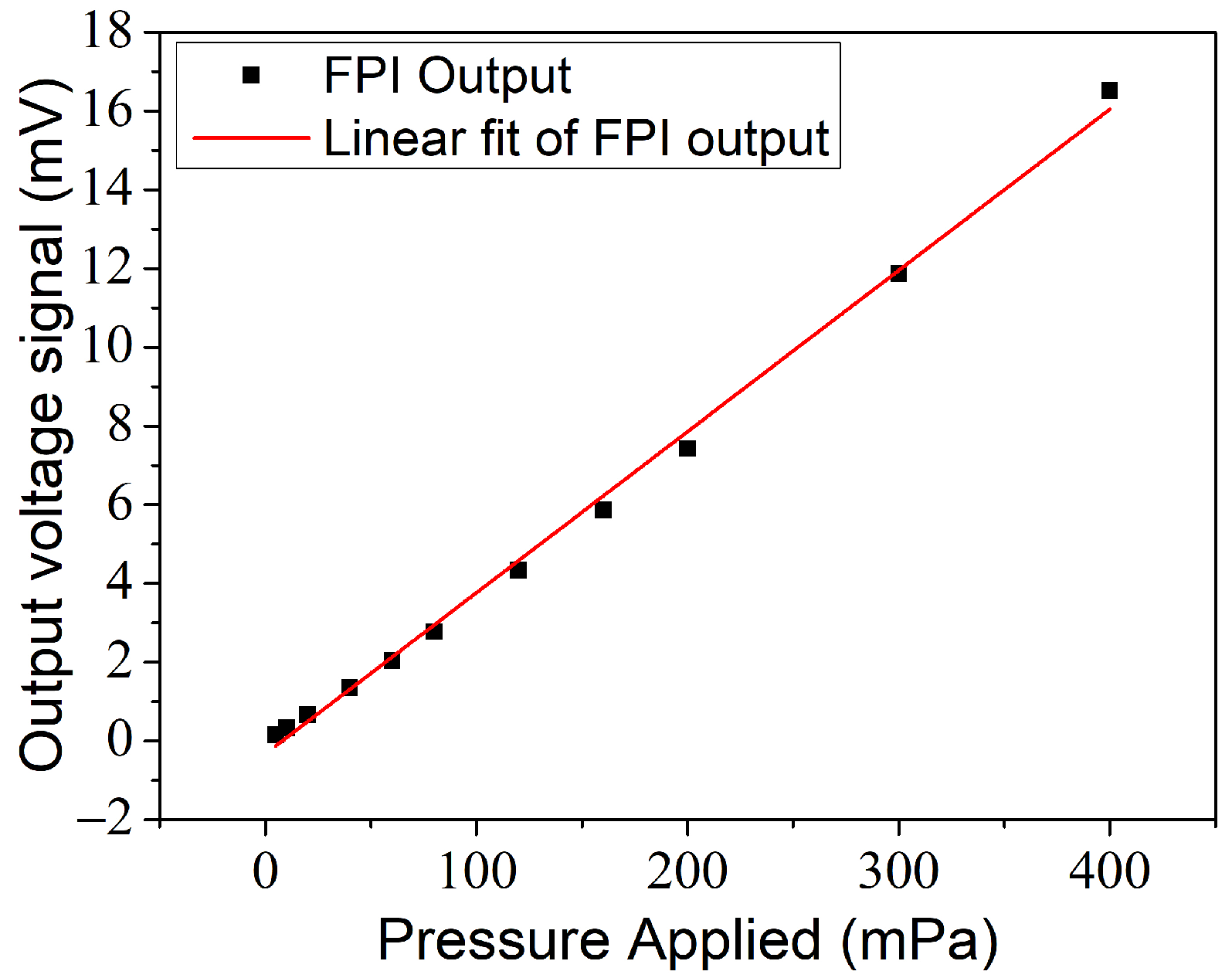
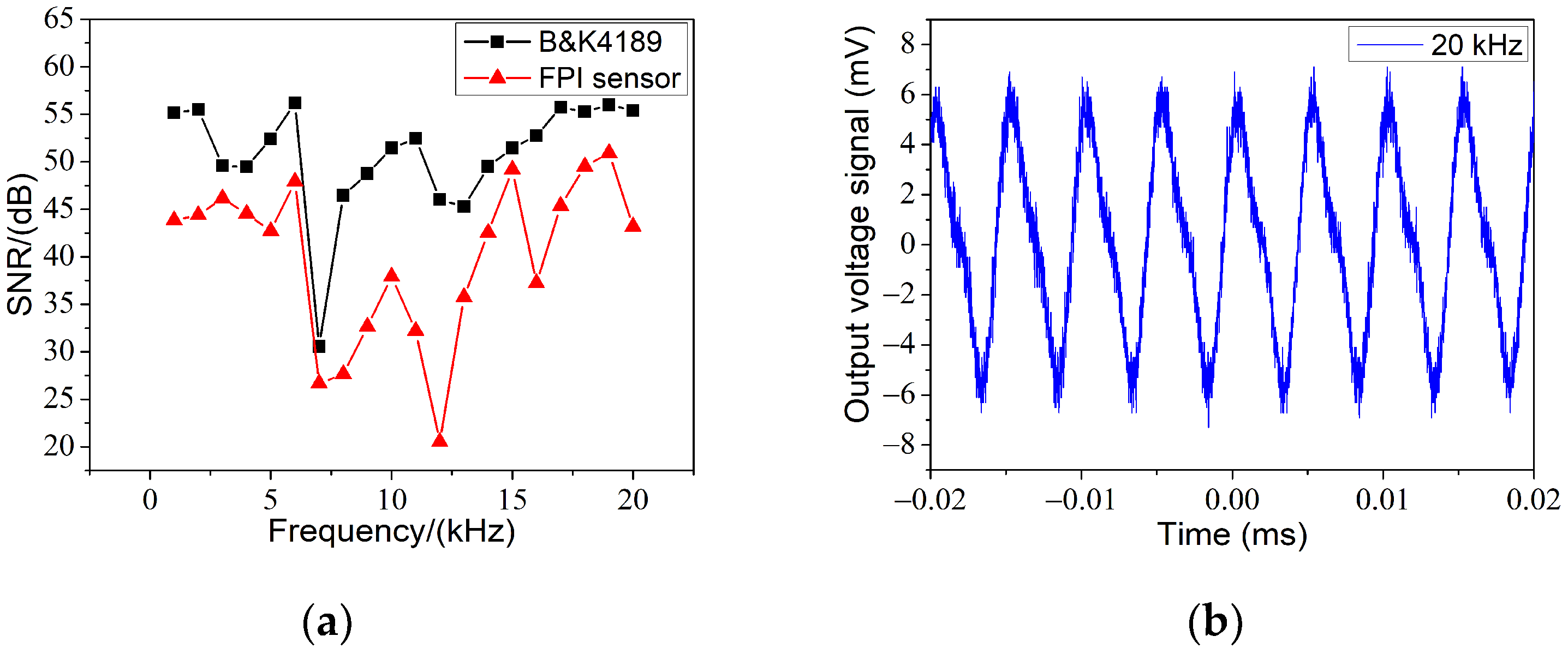
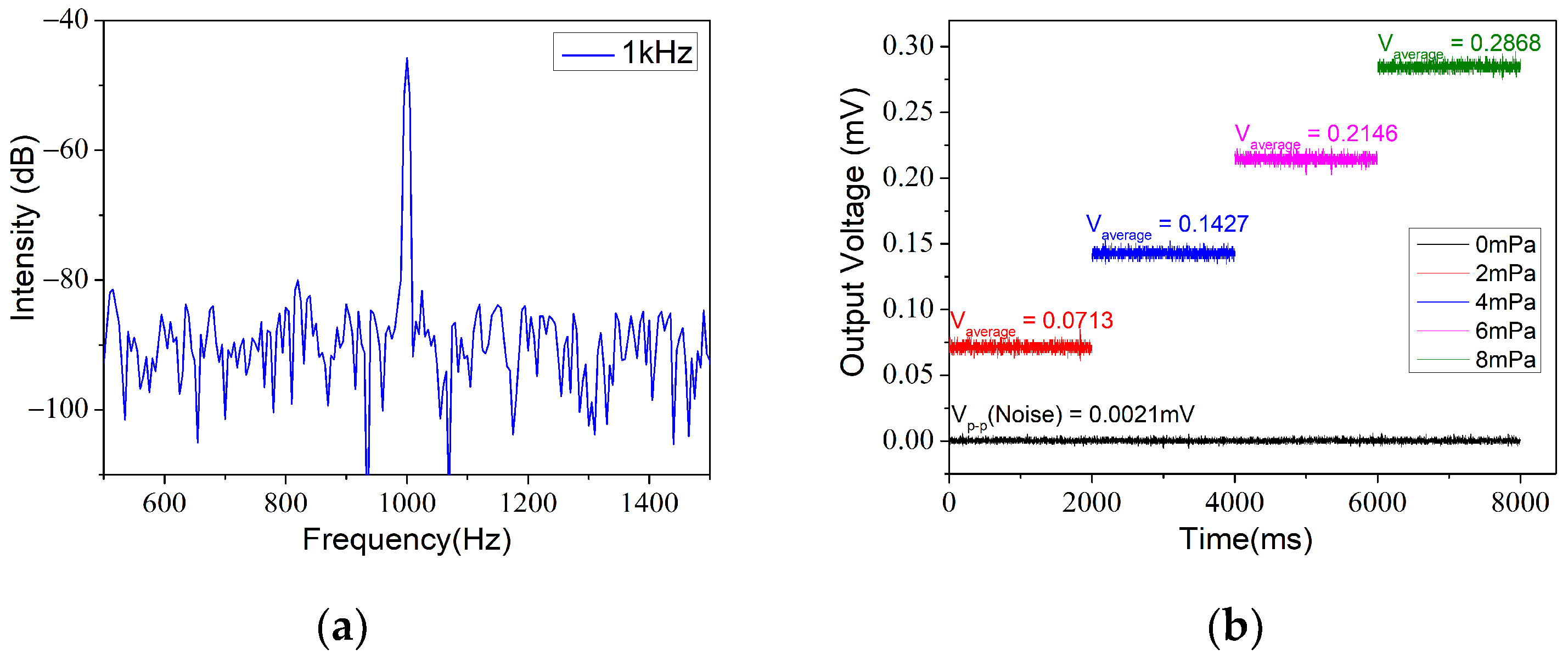
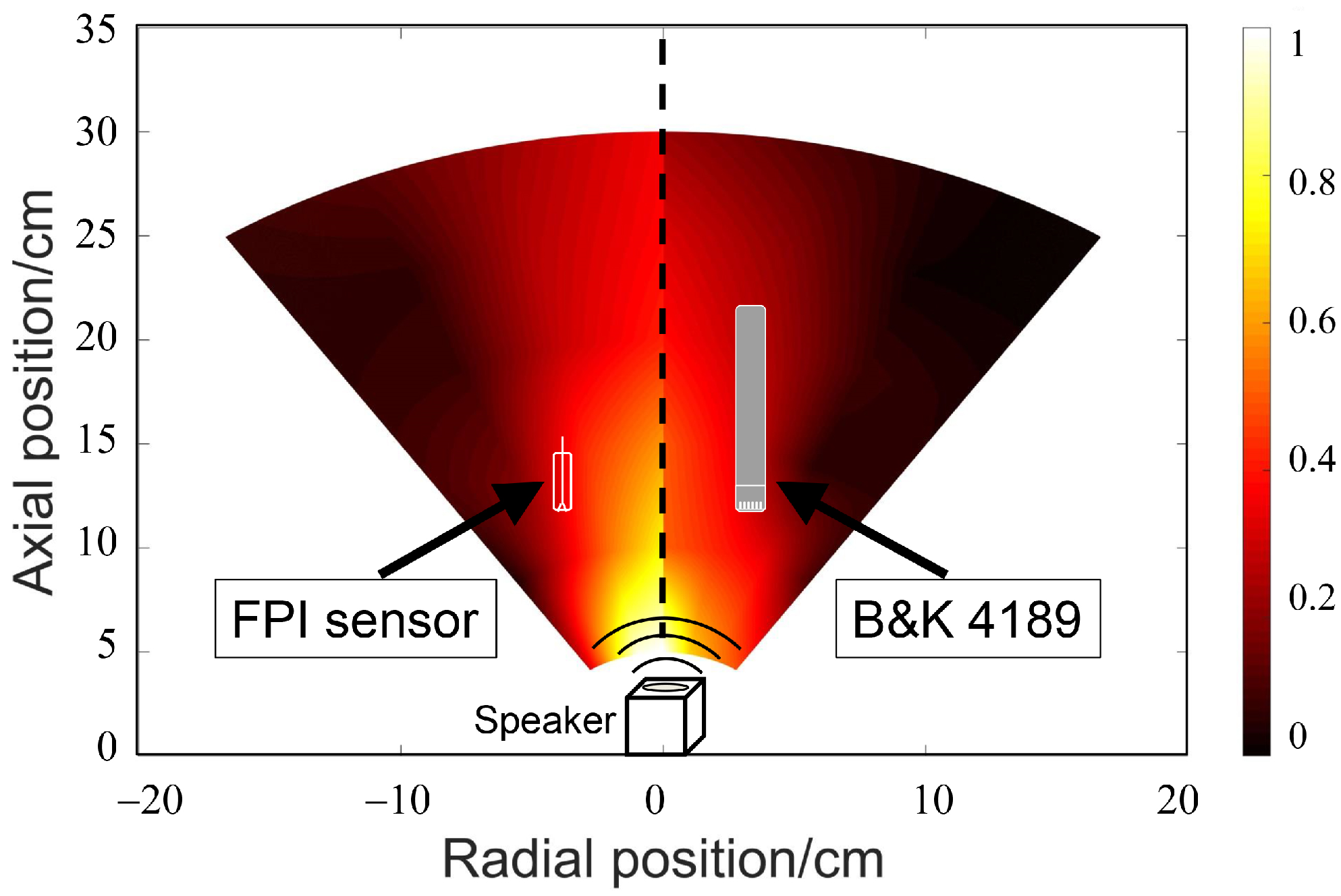
| Sensor | Size | MDP | Sensitivity |
|---|---|---|---|
| FPI | Φ2.4 mm × 10.5 mm | 58.9 /Hz1/2@1 kHz | 33.26 mV/Pa |
| B&K4189 | Φ1.2 cm × 9.5 cm | 8 /Hz1/2 | 50 mV/Pa |
Publisher’s Note: MDPI stays neutral with regard to jurisdictional claims in published maps and institutional affiliations. |
© 2021 by the authors. Licensee MDPI, Basel, Switzerland. This article is an open access article distributed under the terms and conditions of the Creative Commons Attribution (CC BY) license (https://creativecommons.org/licenses/by/4.0/).
Share and Cite
Yao, Q.; Guo, X.; Xie, L.; Sun, L.; Yu, F.; Zhao, X. A Miniature Fabry–Pérot Fiber Interference Sensor Based on Polyvinyl Chloride Membrane for Acoustic Pressure Sensing in Mid–High-Frequency Band. Materials 2021, 14, 7605. https://doi.org/10.3390/ma14247605
Yao Q, Guo X, Xie L, Sun L, Yu F, Zhao X. A Miniature Fabry–Pérot Fiber Interference Sensor Based on Polyvinyl Chloride Membrane for Acoustic Pressure Sensing in Mid–High-Frequency Band. Materials. 2021; 14(24):7605. https://doi.org/10.3390/ma14247605
Chicago/Turabian StyleYao, Qingkai, Xing Guo, Linfang Xie, Li Sun, Fapeng Yu, and Xian Zhao. 2021. "A Miniature Fabry–Pérot Fiber Interference Sensor Based on Polyvinyl Chloride Membrane for Acoustic Pressure Sensing in Mid–High-Frequency Band" Materials 14, no. 24: 7605. https://doi.org/10.3390/ma14247605
APA StyleYao, Q., Guo, X., Xie, L., Sun, L., Yu, F., & Zhao, X. (2021). A Miniature Fabry–Pérot Fiber Interference Sensor Based on Polyvinyl Chloride Membrane for Acoustic Pressure Sensing in Mid–High-Frequency Band. Materials, 14(24), 7605. https://doi.org/10.3390/ma14247605







